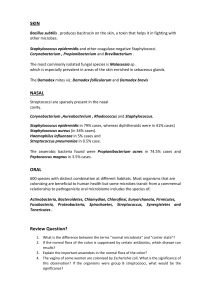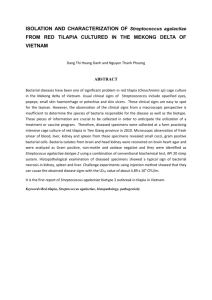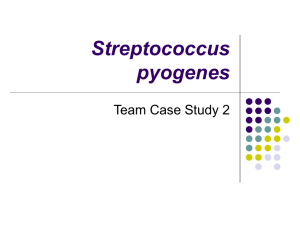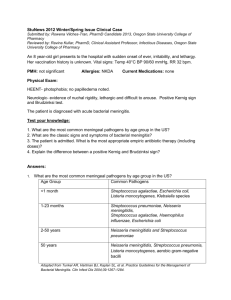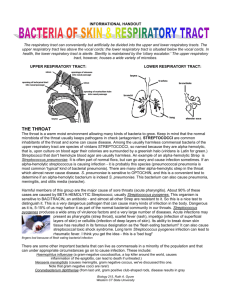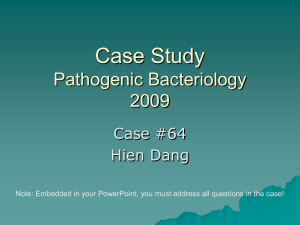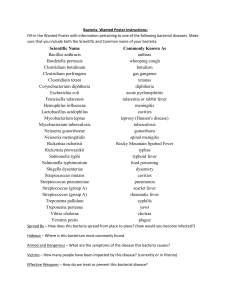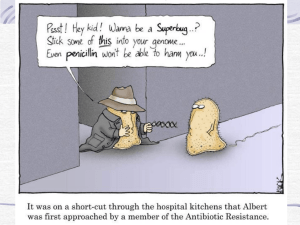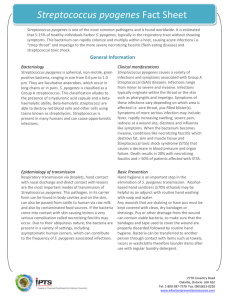STUDENT WEB SITE INFORMATION
advertisement
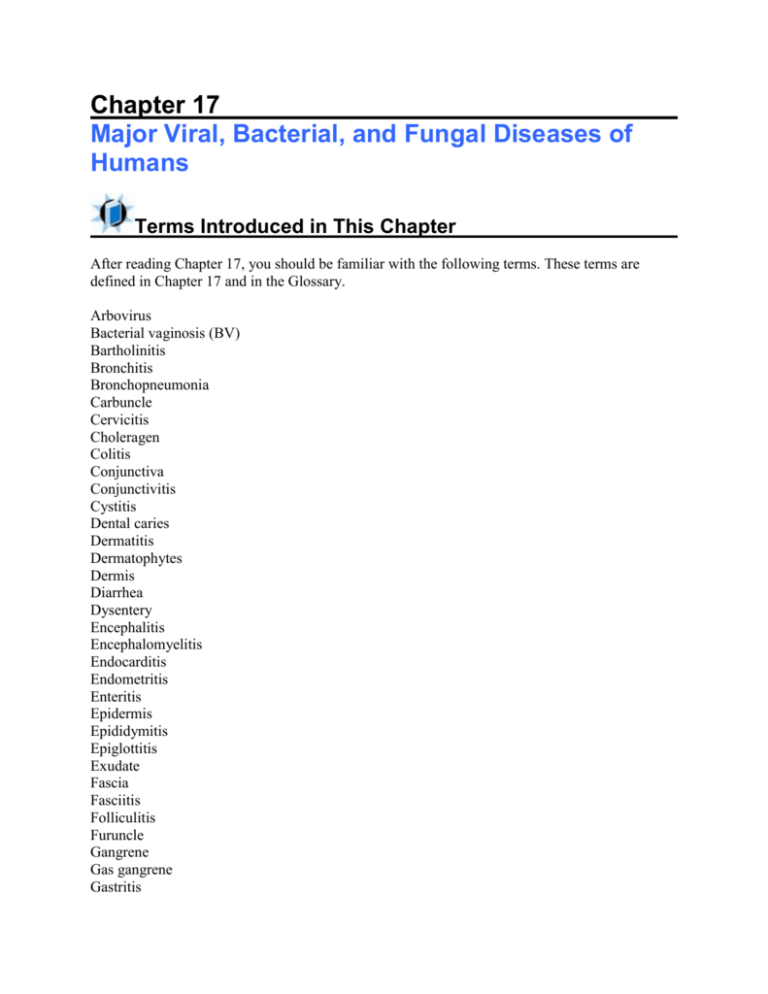
Chapter 17 Major Viral, Bacterial, and Fungal Diseases of Humans Terms Introduced in This Chapter After reading Chapter 17, you should be familiar with the following terms. These terms are defined in Chapter 17 and in the Glossary. Arbovirus Bacterial vaginosis (BV) Bartholinitis Bronchitis Bronchopneumonia Carbuncle Cervicitis Choleragen Colitis Conjunctiva Conjunctivitis Cystitis Dental caries Dermatitis Dermatophytes Dermis Diarrhea Dysentery Encephalitis Encephalomyelitis Endocarditis Endometritis Enteritis Epidermis Epididymitis Epiglottitis Exudate Fascia Fasciitis Folliculitis Furuncle Gangrene Gas gangrene Gastritis Gastroenteritis Gingivitis Hepatitis Ischemia Keratitis Keratoconjunctivitis Laryngitis Lymphadenitis Lymphadenopathy Lymphangitis Malaise Meninges (sing. meninx) Mucormycosis (zygomycosis) Myelitis Myocarditis Necrosis Nephritis Oncogenic Oophoritis Orchitis Otitis externa Otitis media Parotitis Pelvic inflammatory disease (PID) Pericarditis Periodontal disease Periodontitis Pharyngitis Pneumonia Prostatitis Pustule Pyelonephritis Sebaceous gland Sebum Sinusitis Splenomegaly Sty (stye) Tinea infections Transient bacteremia Ureteritis Urethritis Vaginitis Vulvovaginitis Increase Your Knowledge Students seeking additional information about the major viral, bacterial, and fungal infections of humans should consult one of the following books or visit one of the following web sites: Control of Communicable Diseases Manual, 18th ed., by D.L. Heymann. Washington, D.C., American Public Health Association, 2004. The Merck Manual of Medical Information, by R. Berkow. Whitehouse Station, Merck & Company, 1997. The World Health Organization (WHO), www.who.int/en/. If you click on “Health Topics,” you can find information about many different infectious diseases. The Centers for Disease Control and Prevention (CDC), www.cdc.gov. If you click on “A–Z Index,” you can find information about many different infectious diseases. Critical Thinking 1. A group of your friends is discussing some recent meat recalls that involved Escherichia coli O157:H7. They say that, in the future, they are going to avoid hamburgers in fastfood establishments and eat salads only. Explain to them why this will not necessarily protect them from E. coli O157:H7 food poisoning. 2. You’ve just finished hiking with a friend. You suggest that you check each other for ticks. Your friend thinks that your suggestion is silly. Explain to your friend why it is definitely not silly, and name as many tickborne infections as you can. (Refer back to Chapter 11 if necessary.) 3. One of your friends is complaining about her sore throat. You suggest that she get checked for strep throat. She is reluctant. Step up your advice by listing as many complications of streptococcal infections as possible. 4. A friend of yours has read that there is a connection between HIV infection and immunosuppression. However, she doesn’t have a clue as to how the two events are connected. Explain to her the mechanism by which HIV-infected individuals become immunosuppressed, and why AIDS patients die of overwhelming infections caused by a variety of different types of pathogens. Case Studies 1. A 19-year-old woman visits the clinic complaining of a frequent, urgent desire to urinate, a burning sensation during urination, and pain above her pubic bone. The physician suspects cystitis and arranges for the patient to collect a clean-catch, midstream urine specimen. The urine is cloudy and tinged with blood. In the laboratory, a colony count confirms that the patient does have a urinary tract infection. The pathogen causing the infection is producing pink colonies on MacConkey agar. Which one of the following pathogens do you suspect is causing this patient’s cystitis? a. b. c. d. e. 2. A 2-year-old girl is admitted to the hospital with massive tissue destruction along her right arm. The skin is a violet color, and large fluid-filled blisters are present. The patient has a fever, a rapid heart rate, and low blood pressure, and seems confused. Her mother informs the physician that the child had been recovering from chickenpox, and, for the past 2 days, had frequently been scratching at chickenpox lesions on that area of her arm. Once the area appeared to have become infected, the infection spread very rapidly. A Gram-stain of exudate from the infected tissue reveals Gram-positive cocci in chains. The physician suspects that her infection is being caused by _______________. a. b. c. d. e. 3. Clostridium perfringens Clostridium tetani Staphylococcus aureus Streptococcus pneumoniae Streptococcus pyogenes (Group A strep) A 16-year-old girl is admitted to the hospital with severe abdominal cramps and bloody diarrhea. She has a fever of 102F. She has been experiencing her symptoms for the past 3 days, since several hours after eating at a fast-food restaurant with a group of her friends. She recalls that the hamburger she ate was not very well cooked. (It is later learned that the meat being used in that restaurant to prepare hamburgers has been recalled because of bacterial contamination.) All of the following organisms can cause diarrhea, but which is the most likely cause of her illness? a. b. c. d. e. 4. Chlamydia trachomatis Escherichia coli Neisseria gonorrhoeae Proteus mirabilis Staphylococcus saprophyticus A species of Salmonella A species of Shigella Escherichia coli O157:H7 Staphylococcus aureus Vibrio cholerae A 20-year-old man is admitted to the hospital with fever, headache, stiff neck, sore throat, and vomiting. The attending physician suspects that the patient has meningitis and immediately performs a lumbar puncture. A cerebrospinal fluid (CSF) specimen is rushed to the laboratory, where it is processed immediately. After centrifuging an aliquot of the specimen, the sediment is spread onto a microscope slide, fixed, and Gram-stained. Microscopic examination of the Gram-stained specimen reveals numerous white blood cells and numerous Gram-negative diplococci. This information is telephoned to the attending physician, who will now treat the patient for a meningitis caused by _______________. a. b. c. d. e. 5. Haemophilus influenzae Neisseria meningitidis Streptococcus agalactiae (Group B strep) Streptococcus pneumoniae Streptococcus pyogenes (Group A strep) An 80-year-old woman is transferred from a nursing home to the hospital because she is suspected of having pneumonia. She is experiencing chest pain, chills, fever, and shortness of breath. She has a productive cough (meaning that she is coughing up sputum). A Gram-stain of the sputum reveals numerous white blood cells and numerous Gram-positive diplococci. On receipt of the Gram-stain report, the physician treats the patient for a pneumonia caused by _______________. a. b. c. d. e. Haemophilus influenzae Staphylococcus aureus Streptococcus agalactiae (Group B strep) Streptococcus pneumoniae Streptococcus pyogenes (Group A strep) Answers to the Chapter 17 Self-Assessment Exercises in the Text 1. 2. 3. 4. 5. 6. 7. 8. 9. 10. B A D D D D A B B A Answers to the Chapter 17 Case Studies 1. 2. 3. 4. 5. B E C B D Additional Chapter 17 Self-Assessment Exercises (Note: Don’t peek at the answers before you attempt to solve these self-assessment exercises.) Matching Questions A. B. C. D. E. Staphylococcus aureus Staphylococcus epidermidis Streptococcus agalactiae Streptococcus pneumoniae Streptococcus pyogenes _____ 1. _______________ is a common cause of subacute bacterial endocarditis (SBE), and a less common cause of cystitis. _____ 2. Certain strains of _______________ are the so-called flesh-eating bacteria. _____ 3. _______________ is a common cause of bacterial pneumonia, meningitis, and otitis media. _____ 4. _______________ is the most common cause of toxic shock syndrome. _____ 5. _______________ is one of the most common causes of neonatal meningitis. A. B. C D. E. Chlamydia species mold Rickettsia species virus yeast _____ 6. A tinea infection is caused by a _______________. _____ 7. Trachoma is caused by a _______________. _____ 8. Cryptococcosis is caused by a _______________. _____ 9. Any type of wart is caused by a _______________. _____ 10. The most common cause of nongonococcal urethritis is a _______________. True/False Questions _____ 1. Tuberculosis and Hansen’s disease (leprosy) are caused by Mycoplasma species. _____ 2. It is possible for scarlet fever and toxic shock syndrome to be caused by the same pathogen. _____ 3. The most common cause of gas gangrene also causes a type of food poisoning. _____ 4. The diseases caused by Mycobacterium species are referred to as mycoses. _____ 5. Botulism, gas gangrene, and tetanus are all caused by Clostridium species. _____ 6. The causative agent of infectious mononucleosis also causes or is associated with various types of human cancers. _____ 7. Measles, German measles, mumps, and whooping cough are all caused by viruses. _____ 8. -Hemolytic streptococci of oral origin and Staphylococcus epidermidis are common causes of subacute bacterial endocarditis (SBE). _____ 9. Haemophilus influenzae is the most common cause of influenza (“flu”). _____ 10. Meningitis could be caused by a virus, a bacterium, a fungus, or a protozoan. Answers to the Additional Chapter 17 Self-Assessment Exercises Matching Questions 1. 2. 3. 4. 5. 6. 7. 8. 9. 10. B E D A C B A E D A True/False Questions 1. 2. 3. 4. 5. 6. 7. 8. 9. 10. False (tuberculosis and Hansen’s disease are caused by Mycobacterium species) True True False (diseases caused by fungi are referred to as mycoses) True True False (measles, German measles, and mumps are caused by viruses, but whooping cough is caused by a bacterium) True False (influenza is caused by influenza viruses) True
